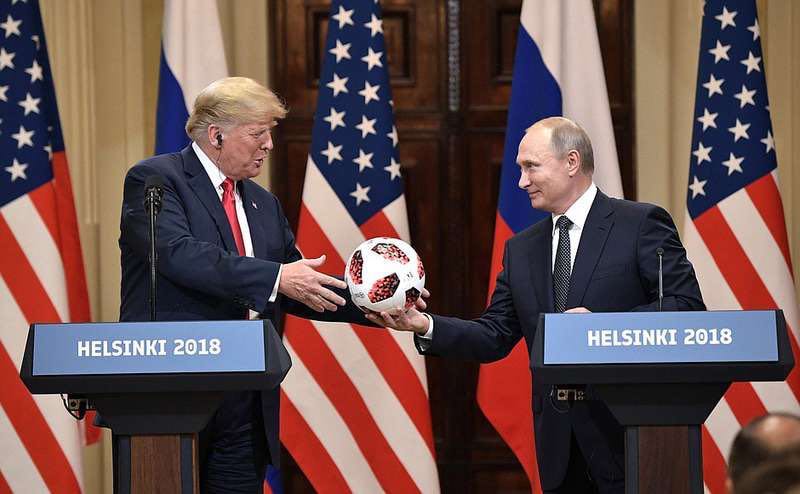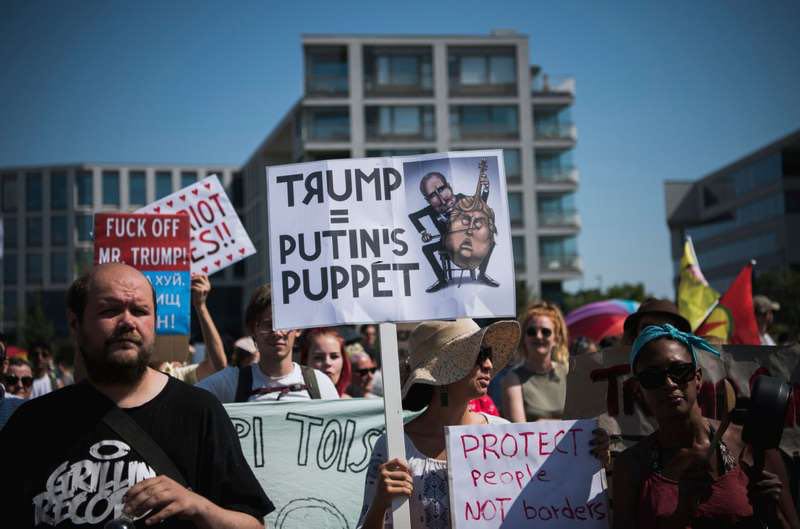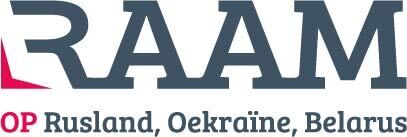The Helsinki summit quickly lost its significance. Trump was confronted with domestic pressure and reversed his statements. The Russian government is in doubt how to proceed. Should it view Trump as a partner who can normalize relations with Russia or should it use him as a tool for disrupting the U.S. foreign policy?
The U.S.-Russia summit in Helsinki lasted just one day, but the battle of interpretations that unfolded around it seems endless. Presidents Donald Trump and Vladimir Putin’s meeting is one of the most enigmatic diplomatic events of recent years. There is virtually no understanding of what the two leaders said, what (if anything) they agreed upon, and what the next steps might be.
 Putin looked like the winner of the Helsinki summit. Photo Kremlin.ru
Putin looked like the winner of the Helsinki summit. Photo Kremlin.ru
But that isn’t because the next steps are being deliberately kept secret. Rather, even those plans that have tentatively been made could quickly dissolve amid mutual misunderstanding and antagonism.
There is only one conclusion that the Russian and U.S. political establishments can agree on: Putin 'won' the July 16 talks. But was the Helsinki summit really all that successful for the Russian leader?
Each country has demonstrated a distinct emotional reaction to Putin’s supposed victory: anger in America, euphoria in Russia. Russian Foreign Minister Sergey Lavrov described the meeting as 'better than super'. Meanwhile, in the West, the hashtag #TreasonSummit began trending in reaction to Trump’s submissive behavior and rhetoric.
Vladimir Putin did indeed look like the winner: at the closing press conference he outlined broad possibilities for future cooperation and recited several Russian proposals, from setting up a council of experts to cooperating on Syria. Meanwhile, Trump looked like a follower. He cast doubts on U.S. intelligence agencies’ findings and demonstrated an eagerness to resolve the crisis in bilateral relations. This made the summit a clear success for Russia.
But now that some time has passed, it is becoming clear that the initial assessments were dominated by emotions, and that Vladimir Putin’s success was more psychological than geopolitical.
Four formats for cooperation
Russia’s main objective in the run-up to the Helsinki meeting was not to reach specific agreements, but rather to institutionalize and legitimize dialogue. Putin offered Trump an assortment of potential initiatives, from broad and international to sensitive and local. For each issue, Moscow prepared a road map with just one goal in mind: to draw the White House back to the negotiating table to discuss all the issues.
Vladimir Putin proposed four new formats for cooperation. The first was the establishment of a council of experts well versed in the history of the two countries. Their mission would be to seek 'points of contact between the two countries'—or, in other words, to work on a positive strategic agenda in U.S.-Russian relations. The United States has yet to respond to this initiative.
Well prepared Russian proposals were met by contradictory rhetoric
The second was the creation of a Russian-American business forum. This is a very ambitious idea, given the sanctions regime and the extreme toxicity of Russian money in the United States. It was cautiously accepted by the U.S. side, as confirmed recently by Secretary of State Mike Pompeo. However, there are reasons to believe the two sides won’t be able to agree on the participants and aims of such a forum.
The third proposal, also acknowledged by Pompeo, was 'to reestablish a working group on anti-terrorism' at the level of the deputy foreign ministers. The other option discussed was establishing dialogue between the national security secretaries—presumably U.S. National Security Advisor John Bolton and Russian Security Council Secretary Nikolai Patrushev. This could raise the stakes in unfinished personnel changes in Russia’s security and foreign policy blocs. A meeting between Bolton and Patrushev is reportedly already under works for August.
Finally, the fourth proposal was a cybersecurity working group. Its prospects remain unclear. Putin pitched this idea to Trump at their first meeting in Hamburg in July 2017. Back then, the White House immediately rejected the idea. The U.S. political establishment perceived it as flagrant trolling by the Russian president, who had been accused of overseeing cyberattacks against U.S. democracy.
Proposals and rhetoric
On Syria, the conversation was provisionally divided between two goals. First, Trump was attempting to essentially create an anti-Iran coalition with Russia. That did not yield anything new. Second, Moscow proposed a humanitarian project envisaging refugees returning to Syria and efforts to develop infrastructure to deliver humanitarian cargo. Ultimately, the idea that Russia would give up Iran and receive something from the U.S. in return, widely discussed before the summit, turned out to be too unrealistic.
Finally, on Ukraine, Putin invited Trump to support the idea of a referendum on special status for the breakaway Donbas region. This was supposed to be an alternative to Moscow’s attempts to achieve legal recognition of the region’s autonomy with a special law or amendments to the Ukrainian Constitution. The White House categorically declined this offer and soon reinforced its position with the Crimea Declaration, which rejected Russia’s annexation of the peninsula.
Russia cannot relate to Trump as a partner and attack the U.S. system at the same time
But are any of these proposals practicable? The breadth of the Russian initiatives is overshadowed by their low likelihood of implementation. Furthermore, the more proactive Putin is, the more vulnerable Trump appears and, thus, the lower the chances are of progress on Putin’s initiatives.
All this explains why the summit looked like a victory for Putin: we can make a list of the Russian president’s objectives and proposals, but it is virtually impossible to say what Trump offered Russia. The intensity and relative transparency of Moscow’s intentions and Putin’s traditional directness stood in stark contrast to Trump’s frequently contradictory rhetoric. The only thing Trump said in his initial remarks at the summit’s closing press conference was that the United States needs to conduct constructive dialogue with Russia. The U.S. president also made abstract references to possible subjects of this dialogue (interference in the U.S. elections, the denuclearization of North Korea, the fight against terrorism, pressure on Iran), but he did not make U.S. national priorities at all clear.
Chaotic information war
The mismatch of Putin and Trump’s agendas in Helsinki created the impression that Trump had no counteroffers to openly make to Putin, that he was losing the initiative and just following Russia’s lead. In this sense, Putin really did outmaneuver Trump. However, this was largely the result of Russia’s acute need to normalize relations and its eagerness to cooperate on the full range of issues. Meanwhile, other than an abstract desire to 'get along,' Trump had no plan of action.
 Back home Trump is confronted with protests and opposition to his foreign policy.
Back home Trump is confronted with protests and opposition to his foreign policy.
As a result, Helsinki quickly lost its significance. It was eclipsed by the 'post-summit'— the escalation of domestic pressure on Trump and the revision of the meeting’s results. The summit 'continued' — without the presidents — as a chaotic information war between the United States and Russia’s respective establishments, a war that could have no winners.
Right after Helsinki, Trump reversed his denial of Russian election interference, invited Putin to visit DC in the fall, and then rescinded the invitation. He also accused Moscow of trying to help Democrats in the midterm elections.
Meanwhile, U.S. legislators began discussing a new sanctions bill that would target investors in Nord Stream-2 gas pipeline and strengthen restrictions on Russia. The United States also arrested Russian citizen Maria Butina, published the harshly worded Crimea Declaration, and accused Russian hackers of attacking the U.S. power grid. All of this is the result of the Helsinki summit and the price that Russia will have to pay for its tête-à-tête with Trump.
Active player...
If Vladimir Putin’s main objective in Helsinki was to restore dialogue with the United States, as many suggest, Russia now appears to have some new doubts: should it view Trump as the ultimate objective, or only as an instrument for promoting Russian foreign policy priorities? These are essentially two different approaches to building relations with Washington. Moscow is torn, trying to make headway on both, but actually creating obstacles to progress.
Under the first approach, where Trump is the objective, the U.S. president can and should be an active player in normalizing bilateral relations. The supporters of this approach, particularly in the diplomatic community, feel that the U.S. president needs time to overcome the anti-Russia sentiment at home and strengthen his standing in the U.S. administration.
They are counting on the Republicans to maintain their majority in Congress after the midterm elections, hoping that—together with economic growth—this will stabilize Trump’s position in the U.S. establishment. If that occurs, Russia could negotiate with Trump on extending the New START Treaty, divide up Syria, and discuss Ukraine.
...or convenient instrument
Under the second approach, where Trump is the instrument, the U.S. president is seen not as a practitioner of U.S. foreign policy but as a mechanism for disrupting it. Part of the Russian elite, particularly its members from the security services, views Trump as a political outsider who is rejected by the U.S. establishment. He is a convenient instrument for sowing chaos in U.S. politics, testing the strength of the Euro-Atlantic partnership, and splintering the West’s traditional common geopolitical front.
These conservative players trust neither Trump nor any forums created with his involvement. Their skepticism is based on their deep conviction that the entire U.S. system seeks to destroy Russia and subvert the Putin regime. For them, the summit was a serious victory if only because it prompted a wave of panic in the United States about Trump’s potential treason.
This political camp has no intention of reaching agreements with Trump or the United States. Furthermore, it will be opposed to any hint of normalizing bilateral relations, because that would stand in the way of the policy of fueling chaos and disarray in the United States. One cannot simultaneously invest in Trump as a partner and attack the U.S. system, because, in the latter scenario, the system will always seek to destroy Trump.
The results of the 'post-summit' show that the concept of 'Trump as the instrument' is more accessible and achievable for Russia, while the concept of 'Trump as the ultimate objective' leaves fewer hopes for real results.
Yes, Putin was able to come off as the stronger and more mature leader, and it looked like Trump was afraid to say to Putin’s face what the U.S. elite wanted him to say. But if the Kremlin wants to invest in Trump, it will need greater flexibility and a better understanding of the significance of the 'Russia problem' for the U.S. establishment. So far, Russia’s elite appears distinctly unprepared for that.
This article was published originally on the website of the Carnegie Moscow Center

